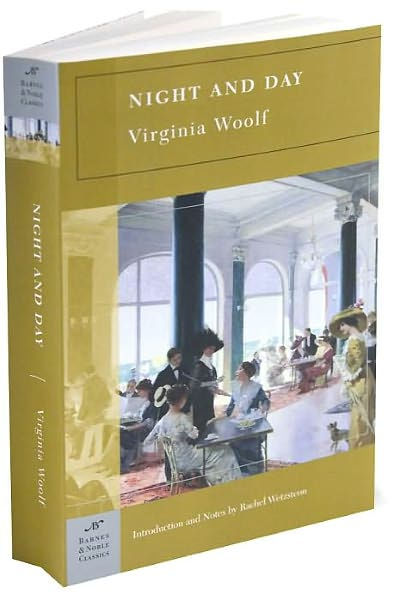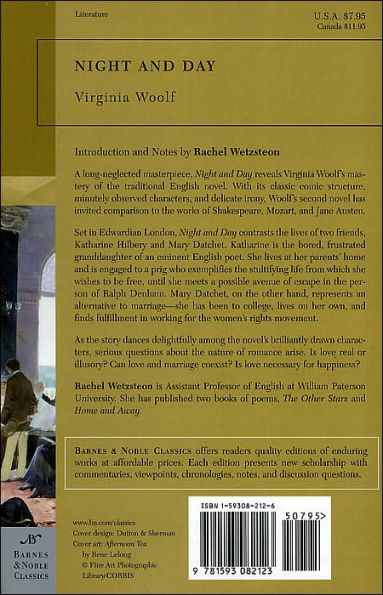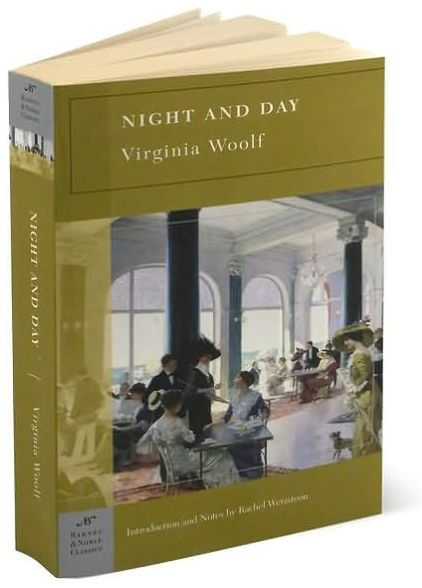- New introductions commissioned from today's top writers and scholars
- Biographies of the authors
- Chronologies of contemporary historical, biographical, and cultural events
- Footnotes and endnotes
- Selective discussions of imitations, parodies, poems, books, plays, paintings, operas, statuary, and films inspired by the work
- Comments by other famous authors
- Study questions to challenge the reader's viewpoints and expectations
- Bibliographies for further reading
- Indices & Glossaries, when appropriate
A long neglected masterpiece, Night and Day reveals Virginia Woolf’s mastery of the traditional English novel. With its classic comic structure, minutely observed characters, and delicate irony, Woolf’s second novel has invited comparison to the works of Shakespeare, Mozart, and Jane Austen.
Set in Edwardian London, Night and Day contrasts the lives of two friends, Katherine Hilbery and Mary Datchet. Katherine is the bored, frustrated granddaughter of an eminent English poet. She lives at her parents’ home and is engaged to a prig who exemplifies the stultifying life from which she wishes to be free, until she meets a possible avenue of escape in the person of Ralph Denham. Mary Datchet, on the other hand, represents an alternative to marriage—she has been to college, lives on her own, and finds fulfillment in working for the women’s rights movement.
As the story dances delightfully among the novel’s brilliantly drawn characters, serious questions about the nature of romance arise. Is love real or illusory? Can love and marriage coexist? Is love necessary for happiness?
Rachel Wetzsteon is Assistant Professor of English at William Paterson University. She has published two books of poems, The Other Stars and Home and Away.
- New introductions commissioned from today's top writers and scholars
- Biographies of the authors
- Chronologies of contemporary historical, biographical, and cultural events
- Footnotes and endnotes
- Selective discussions of imitations, parodies, poems, books, plays, paintings, operas, statuary, and films inspired by the work
- Comments by other famous authors
- Study questions to challenge the reader's viewpoints and expectations
- Bibliographies for further reading
- Indices & Glossaries, when appropriate
A long neglected masterpiece, Night and Day reveals Virginia Woolf’s mastery of the traditional English novel. With its classic comic structure, minutely observed characters, and delicate irony, Woolf’s second novel has invited comparison to the works of Shakespeare, Mozart, and Jane Austen.
Set in Edwardian London, Night and Day contrasts the lives of two friends, Katherine Hilbery and Mary Datchet. Katherine is the bored, frustrated granddaughter of an eminent English poet. She lives at her parents’ home and is engaged to a prig who exemplifies the stultifying life from which she wishes to be free, until she meets a possible avenue of escape in the person of Ralph Denham. Mary Datchet, on the other hand, represents an alternative to marriage—she has been to college, lives on her own, and finds fulfillment in working for the women’s rights movement.
As the story dances delightfully among the novel’s brilliantly drawn characters, serious questions about the nature of romance arise. Is love real or illusory? Can love and marriage coexist? Is love necessary for happiness?
Rachel Wetzsteon is Assistant Professor of English at William Paterson University. She has published two books of poems, The Other Stars and Home and Away.

Night and Day (Barnes & Noble Classics Series)
496
Night and Day (Barnes & Noble Classics Series)
496Related collections and offers

Product Details
| ISBN-13: | 9781593082123 |
|---|---|
| Publisher: | Barnes & Noble |
| Publication date: | 03/01/2005 |
| Series: | Barnes & Noble Classics Series |
| Pages: | 496 |
| Sales rank: | 30,903 |
| Product dimensions: | 5.19(w) x 8.00(h) x 1.24(d) |
About the Author

Customer Reviews
Explore More Items
At first glance, Three Lives seems to be three straightforward portraits of women living in the early twentieth century. “The Good Anna” describes an exacting German house servant;
WITH AN INTRODUCTION BY FRANCESCA WADE
Who better to serve as a guide to great books and their authors than Virginia Woolf?
In the early years of its existence, the Times Literary
An account of Woolf's life during the period in which To the Lighthouse and The Waves were written. "Her steel-trap mind and elegant prose...make this a most valuable and pleasurable book"
Set in late-nineteenth-century







